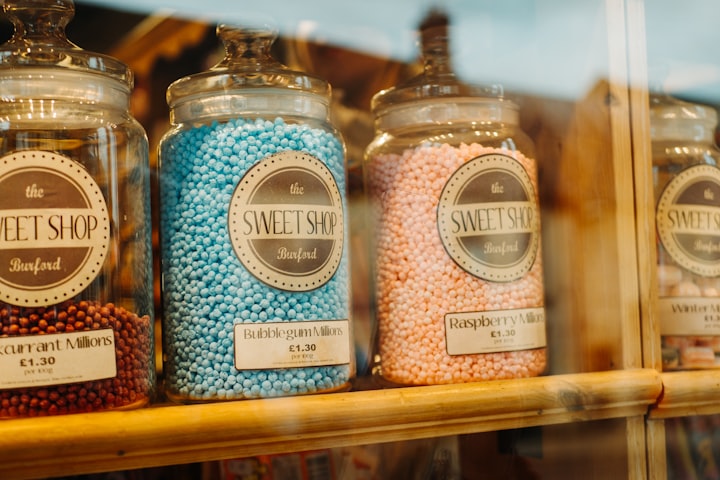Killer Candy: The 1858 Bradford Sweets Poisoning
A tragic lesson from history

We all love candy. They're sweet, flavorful, and make us happy. But as the old adage goes, "Too much of anything is bad for you." And in the case of the 1858 Bradford Sweets poisoning, it wasn't just bad; it was deadly.
A deadly treat
Candy is often considered a harmless treat, but in late October of 1858, the seemingly innocent treat turned out to be the culprit behind one of history's most notorious cases of poisoning.
The location is Bradford, a bustling industrial town in the north of England, and winter was creeping in. As the townspeople braced themselves for the colder days ahead, an unexplained epidemic started to sweep through the streets. Sore throats, pounding headaches, stomach aches, and the unholy duo of vomiting and diarrhea plagued the unfortunate victims.
As the mystery illness took its toll, confusion filled the air. The townspeople were completely baffled, and the local doctors were scratching their heads in confusion as they tried their best to unravel the enigma.
Unexplained deaths
This unexplained illness claimed its first victims with the unfortunate passing of two young boys, aged nine and eleven, on a dark Sunday morning of the 31st of October, 1858.
However, at the time, their grim deaths were attributed to the dire living conditions that plagued Bradford. After all, in the 1840s and 1850s, the city was notorious for its wretched hovels, lacking in furnishings, ventilation, and basic sanitation. It was thought that the children died of cholera as the symptoms of this mysterious illness, such as vomiting, abdominal pains, and diarrhea were identical.

Soon, the deaths started to pile up and countless cases of sudden and violent illnesses emerged, causing the townsfolk to go from bewildered to fearful. The police, believing something sinister was afoot, began investigating.
At #30 Jowett Street, tragedy struck again when two young brothers, Orlando and John Henry Burran, aged five and three, respectively, met an untimely demise.
When police arrived at the abode, their grief-stricken father, Mark Burran, raised concerns about the peppermint humbugs he had recently purchased, suspecting they may be linked to the heartbreaking incident. To ascertain the truth, a young man present at the scene bravely volunteered to test the candies. After consuming two of them, he swiftly became gravely ill, confirming the father's suspicions.
Indeed, after further investigation, it was soon discovered that all the affected individuals had one thing in common: they had all consumed sweets from the same confectionery store.
Humbug Billy
William Hardaker's humble sweet shop stood in the bustling Green Market of Bradford, England. Amidst the dazzling array of goodies that adorned his shelves, one treat stood out among the rest: the one and only humbug. This hard-boiled confection, meticulously crafted with a mixture of sugar, gum, and a dash of peppermint magic, bewitched the taste buds of consumers far and wide.
The locals, so captivated by the humbug, bestowed upon William Hardaker the moniker "Humbug Billy."
However, Humbug Billy didn't actually make the candy; he merely sold it. Billy bought his inventory from a nearby sweet-maker and wholesale confectionery dealer, Joseph Neal. Neal, in turn, sourced the ingredients for such sweets from druggist Charles Hodgson.
A lawless world
Now, before we start casting stones at Charles Hodgson, it should be noted that during the Victorian era, regulations on sweets were practically non-existent.
In the mid-1800s, candy was a luxury item that was often sold as loose pieces, weighed out on scales by individual vendors. And since sugar was a precious commodity, most sweet artisans sought to stretch its limits by incorporating a peculiar ingredient called daff.
What's daff I hear you asking? Daff was an intriguing concoction, crafted from plaster of Paris, powdered limestone, and a touch of sulphate of lime. Although it didn't contribute to the sweetness of the final creation, daff played a crucial role in expanding the confections' volume and serving as a cost-cutting measure.

The wheels were set in motion on Monday, October 18, 1858, when a routine assignment turned into a harrowing tale. Joseph Neal dispatched his lodger, James Archer, to Charles Hodgson's shop, a druggist in Baildon Bridge, Shipley. The mission was straightforward: procure 12 pounds of daff.
Upon arriving at the druggist's premises, Archer was informed that Hodgson, the drug chemist, was indisposed due to illness. Instead, William Goddard, a fresh-faced addition to Hodgson's workforce, stood in his place.
Archer told the young apprentice what we wanted, and Goddard consulted Hodgson, who was lying ill upstairs. Upon hearing the request for 12 lbs. of daff, Hodgson said the fetching of the daff would have to wait until he recovered and returned to work.
When Goddard relayed this message to Archer, Archer was not having it and demanded service. Reluctantly, Hodgson gave in, and told his young apprentice that he could find the daff in a cask in a corner of the attic.
Armed with this limited set of instructions, the young apprentice ventured up to the dimly lit confines of an attic room. Goddard found the cask, dug out 12 pounds of the white powder, and sold it to Archer.
It was later discovered that Goddard had not sold Archer daff but 12 pounds of a far more sinister substance-a noxious and lethal powder known as arsenic trioxide. This deadly powder had the capacity to extinguish the lives of up to 2,000 individuals.
But how had such a deadly mix-up occurred? For reasons unknown, the cask of daff and the cask of arsenic were located next to each other in the corner. Neither cask bore any labels, providing no indication of their perilous contents.
As a result of this series of events, around 20 people died, with over 200 becoming seriously ill from arsenic poisoning.
Aftermath
Once the story unfolded, the individuals involved, Goddard, Hodgson, and Neal, found themselves facing trial and charged with manslaughter. However, when the case reached York Assizes in December 1858, all three were ultimately discharged.
Yet the public was still outraged, and the Bradford sweets poisoning became a game-changer in the British food and confectionery industry. The tragedy shed light on the imperative nature of safeguarding the safety of medicines and consumer products and was a major contributing factor to the Pharmacy Act 1868, which forced pharmacies to keep a careful record of how poisons were bought, sold and stored.
This historic piece of legislation not only restricted the distribution of poisons and hazardous drugs exclusively to qualified pharmacists and druggists but also laid the foundation for a comprehensive regulatory framework. A framework that demanded proper labelling of drugs, a practice that continues to this day, ensuring that consumers are well-informed about the medications they take.
But the story doesn't end there. Recognizing the pervasive issue of food adulteration during that era, another groundbreaking law was enacted in 1875, the Sale of Food and Drugs Act. This visionary legislation aimed to tackle the widespread problem of food contamination and to guarantee the quality and purity of consumables for all. It was a monumental step forward in improving public health and safety.
Conclusion
The 1858 Bradford sweets poisoning remains one of the most horrific incidents in confectionary history. It exposed the dangers of unregulated food production and made the public appreciate the importance of product labelling.
About the Creator
Chelsea Rose
I never met a problem I couldn't make worst.






Comments (1)
Fascinating and instructive story!